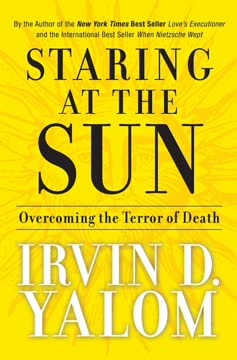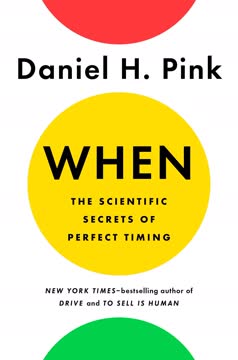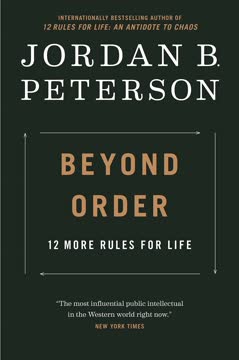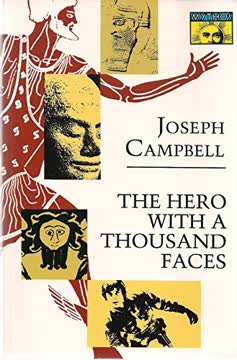Key Takeaways
1. The Hero's Journey: A Path to Self-Discovery and Transformation
The hero's journey is first about taking a journey to find the treasure of your true self, and then about returning home to give your gift to help transform the kingdom-and, in the process, your own life.
Stages of the journey. The hero's journey consists of three main stages: preparation, journey, and return. In the preparation stage, we develop our ego strength and learn basic life skills. The journey stage involves facing challenges, confronting our fears, and discovering our true selves. Finally, the return stage is about bringing our newfound wisdom and gifts back to transform our lives and the world around us.
Universal pattern. This journey is not limited to mythical heroes or extraordinary individuals. It is a universal pattern that applies to everyone's life, offering a framework for personal growth and transformation. By recognizing and embracing this pattern, we can better understand our own struggles and triumphs, finding meaning and purpose in our experiences.
Continuous growth. The hero's journey is not a one-time event but a spiral process that we repeat throughout our lives. Each time we face a new challenge or transition, we have the opportunity to embark on a new journey, gaining deeper insights and developing greater wisdom with each cycle.
2. Archetypes: Universal Patterns Shaping Our Lives and Personalities
Each archetype that comes into our lives brings with it a task, a lesson, and ultimately a gift.
Twelve key archetypes. Pearson identifies twelve primary archetypes that guide us through different stages of life:
- Innocent and Orphan: Dealing with trust and disillusionment
- Warrior and Caregiver: Learning responsibility and compassion
- Seeker and Lover: Discovering identity and connection
- Destroyer and Creator: Embracing change and innovation
- Ruler and Magician: Claiming power and transformation
- Sage and Fool: Seeking wisdom and joy
Psychological development. These archetypes represent universal patterns of human behavior and experience. They shape our personalities, influence our choices, and guide our psychological development. By understanding and working with these archetypes, we can gain valuable insights into our own motivations, strengths, and challenges.
Balance and integration. While we may have dominant archetypes at different stages of life, true growth comes from integrating multiple archetypal energies. This integration allows us to develop a more balanced and flexible approach to life, drawing on different strengths as needed to face various challenges and opportunities.
3. Ego Development: Building a Strong Foundation for Growth
The Ego is the seat of consciousness, the recognition that there is an "I" separate from the mother and the rest of the world, an "I" that can affect that world.
Establishing boundaries. Ego development is crucial for creating a sense of self separate from others and the environment. It involves learning to set boundaries, assert our needs, and navigate the world effectively. This process typically begins in childhood and continues throughout our lives.
Four key archetypes. The archetypes associated with ego development are:
- Innocent: Developing trust and optimism
- Orphan: Learning interdependence and realism
- Warrior: Cultivating courage and discipline
- Caregiver: Fostering compassion and generosity
Balancing act. A healthy ego is neither too rigid nor too weak. It provides a stable foundation for personal growth while remaining flexible enough to adapt to new experiences and insights. This balance allows us to engage with the world confidently while remaining open to deeper truths and transformative experiences.
4. Soul Exploration: Embracing Mystery and Authenticity
Soul is the part of the psyche that connects us with the eternal and provides a sense of meaning and value in our lives.
Journey inward. Soul exploration involves delving into the deeper, often hidden aspects of ourselves. It requires us to confront our fears, embrace uncertainty, and open ourselves to experiences that challenge our preconceptions. This journey often leads to a greater sense of authenticity and connection to something larger than ourselves.
Four soul archetypes. The archetypes associated with soul development are:
- Seeker: Yearning for deeper meaning and purpose
- Destroyer: Letting go of old patterns and illusions
- Lover: Embracing passion and connection
- Creator: Giving birth to our authentic selves
Transformative experiences. Soul exploration often involves initiation experiences that shake us out of our comfort zones and force us to confront life's mysteries. These experiences can be challenging but ultimately lead to greater wisdom, compassion, and a deeper understanding of our place in the world.
5. Self-Expression: Manifesting Your True Identity in the World
The Self signifies the achievement of a sense of genuine identity. When the Self is born, we know who we are, the disjointed parts of our psyche come together, and we experience wholeness and integrity.
Integration of ego and soul. Self-expression is the result of successfully integrating our ego strengths with our soul's deeper wisdom. It involves finding authentic ways to manifest our true identity in the world, balancing our individual needs with the needs of others and the larger community.
Four self archetypes. The archetypes associated with self-expression are:
- Ruler: Taking responsibility for our lives and communities
- Magician: Transforming ourselves and our environment
- Sage: Seeking wisdom and understanding
- Fool: Embracing joy and spontaneity
Creative manifestation. Expressing our true selves often involves finding creative ways to bring our unique gifts into the world. This may include pursuing a vocation that aligns with our deepest values, cultivating relationships that support our growth, or engaging in activities that allow us to experience flow and joy.
6. Balancing Opposites: Integrating Masculine and Feminine Energies
The birth of the true Self always comes out of a marriage of the inner man and woman.
Beyond gender stereotypes. True psychological wholeness involves integrating both masculine and feminine energies, regardless of one's biological sex. This integration allows for a more balanced and flexible approach to life, drawing on both assertive and receptive qualities as needed.
Complementary strengths. Masculine energy is often associated with:
- Assertiveness and action
- Logic and analysis
- Independence and individuality
Feminine energy is often associated with:
- Receptivity and intuition
- Emotion and empathy
- Connection and community
Cultural implications. Recognizing the value of both masculine and feminine energies has implications not only for personal growth but also for creating more balanced and harmonious societies. It challenges traditional gender roles and encourages a more inclusive and holistic approach to leadership, relationships, and problem-solving.
7. Cultural Diversity: Honoring Different Paths to Heroism
If we want a transformed kingdom, we will need to recognize the potential for heroism and the capacity for wisdom of all people.
Diverse expressions of heroism. The hero's journey takes different forms across cultures, genders, and individual experiences. Recognizing and valuing these diverse paths enriches our understanding of human potential and challenges narrow definitions of heroism.
Cultural wisdom. Different cultures have developed unique strengths and insights:
- Western cultures: Individual achievement and innovation
- Eastern cultures: Harmony and spiritual wisdom
- Indigenous cultures: Connection to nature and community
Global transformation. By honoring and learning from diverse cultural traditions, we can create a more inclusive and holistic approach to addressing global challenges. This requires moving beyond cultural stereotypes and recognizing the valuable contributions that all people and traditions can make to our collective growth and transformation.
8. The Power of Myth: Uncovering Your Personal Life Story
To know your story is to know who you are.
Personal mythology. Each of us has a unique life story or personal myth that shapes our identity and guides our choices. Uncovering and understanding this story can provide valuable insights into our motivations, challenges, and potential for growth.
Rewriting your story. Once we become aware of our personal myth, we have the power to rewrite it. This process involves:
- Recognizing limiting beliefs and patterns
- Identifying archetypes and themes in our lives
- Imagining new possibilities and directions
- Taking concrete steps to manifest our revised story
Collective transformation. As we work to transform our individual stories, we contribute to the larger narrative of human evolution. By consciously engaging with our personal myths and those of others, we participate in the ongoing creation of a more compassionate, wise, and interconnected world.
Last updated:
FAQ
What's Awakening the Heroes Within about?
- Exploration of Archetypes: The book explores twelve archetypes that represent different facets of the human experience, such as the Innocent, Orphan, Warrior, and Caregiver. Each archetype offers unique lessons and gifts for personal growth.
- Hero’s Journey Framework: Carol S. Pearson uses the hero's journey as a metaphor for self-discovery, consisting of stages like preparation, the journey itself, and the return, each linked to specific archetypes.
- Integration of Self: It emphasizes the importance of integrating the Ego, Soul, and Self to achieve wholeness, encouraging readers to confront inner challenges and embrace their unique gifts.
Why should I read Awakening the Heroes Within?
- Personal Growth Tool: The book serves as a practical guide for understanding oneself and navigating life's challenges, offering insights into the archetypes that influence behaviors and decisions.
- Universal Relevance: Themes of heroism, self-discovery, and transformation resonate with people at all life stages, providing valuable perspectives for both beginners and those seeking deeper understanding.
- Empowerment through Knowledge: Learning about the archetypes empowers readers to take charge of their lives, fostering a sense of agency and purpose by recognizing their potential heroism.
What are the key takeaways of Awakening the Heroes Within?
- Understanding Archetypes: The twelve archetypes provide a framework for understanding different aspects of ourselves and our journeys, each teaching valuable lessons for personal development.
- Continuous Growth: The hero's journey emphasizes that personal growth is ongoing, with each unique journey involving challenges that lead to transformation.
- Integration of Self: Balancing the Ego, connecting with the Soul, and expressing the true Self are essential for achieving wholeness and living authentically.
What are the twelve archetypes discussed in Awakening the Heroes Within?
- Innocent: Represents trust and optimism, learning to navigate the world with faith despite challenges.
- Orphan: Embodies feelings of abandonment, striving for interdependence and empathy by processing pain.
- Warrior: Symbolizes courage and assertiveness, developing discipline to protect boundaries and achieve goals.
- Caregiver: Focuses on nurturing and compassion, balancing self-care with helping others to foster community.
- Seeker: Represents the quest for truth, driven by curiosity to explore the self and the world.
- Destroyer: Associated with transformation, confronting fears to teach humility and embrace change.
- Lover: Embodies passion and connection, embracing love and relationships fully.
- Creator: Represents individuality, focusing on authenticity and bringing ideas to life.
- Ruler: Symbolizes order and responsibility, leading with integrity for community well-being.
- Magician: Focuses on transformation, aligning with the cosmos to harness potential for change.
- Sage: Represents wisdom, guiding self-reflection and the pursuit of knowledge.
- Fool: Embodies joy, encouraging playfulness and acceptance of life's unpredictability.
What is the significance of the hero's journey in Awakening the Heroes Within?
- Metaphor for Growth: The hero's journey is a powerful metaphor for personal development, illustrating the process of facing challenges and transforming oneself.
- Stages of the Journey: Divided into preparation, the journey itself, and the return, each stage is linked to specific archetypes guiding individuals through experiences.
- Collective Transformation: Emphasizes contributing to the greater good, as individuals bring back insights and gifts to help transform their communities.
How can I apply the concepts from Awakening the Heroes Within to my life?
- Identify Your Archetypes: Reflect on which archetypes resonate with you and how they manifest in your life, providing insights into behaviors and motivations.
- Embrace Your Journey: Recognize personal growth as a continuous journey, embracing challenges as opportunities for transformation and self-discovery.
- Foster Integration: Work on integrating the Ego, Soul, and Self to live authentically and contribute meaningfully to your community.
What are some exercises or practices suggested in Awakening the Heroes Within?
- Heroic Myth Index: A self-assessment tool to identify active archetypes in your life, guiding personal reflection and growth.
- Daydreaming Exercises: Engage in daydreaming to explore desires, fears, and aspirations, clarifying personal goals and motivations.
- Creative Expression: Use creative outlets like drawing or writing to express archetypes' influence, deepening self-awareness and facilitating growth.
What are the shadow sides of the archetypes in Awakening the Heroes Within?
- Innocent's Shadow: May exhibit denial and unrealistic optimism, leading to vulnerability and disappointment.
- Orphan's Shadow: Can manifest as cynicism and victimization, creating isolation and hindering growth.
- Warrior's Shadow: May become ruthless, using power selfishly, leading to destructive behaviors.
- Caregiver's Shadow: Can become a martyr, sacrificing self-needs, resulting in resentment and burnout.
- Seeker's Shadow: May become a perfectionist, striving for unattainable goals, leading to frustration.
- Destroyer's Shadow: Can manifest as self-destructive behaviors, creating cycles of pain.
- Lover's Shadow: May become overly dependent on relationships, hindering autonomy.
- Creator's Shadow: Can become obsessive, stifling creativity and productivity.
- Ruler's Shadow: May become tyrannical, imposing control, creating conflict.
- Magician's Shadow: Can engage in manipulation, leading to mistrust.
- Sage's Shadow: May become judgmental, creating barriers to understanding.
- Fool's Shadow: Can become reckless, leading to chaos and instability.
What are the best quotes from Awakening the Heroes Within and what do they mean?
- “The hunt isn’t over until both your heart and your belly are full.”: Emphasizes fulfilling both emotional and physical needs for true satisfaction.
- “The hero’s journey is first about taking a journey to find the treasure of your true self.”: Highlights the quest for self-discovery as key to transformation.
- “Taking your journey requires you to leave behind the illusion of your insignificance.”: Encourages recognizing inherent value and potential, embracing one's journey.
How does Awakening the Heroes Within address cultural diversity?
- Cultural Context: Emphasizes understanding how cultural backgrounds influence archetype expression, fostering empathy and connection.
- Valuing Different Perspectives: Encourages honoring unique gifts and wisdom from different cultures for a richer understanding of the human experience.
- Collective Journey: Highlights interconnectedness of individual journeys within a larger cultural context, enhancing personal growth and collective transformation.
How does the Fool contribute to personal growth according to Awakening the Heroes Within?
- Embracing Playfulness: Encourages a sense of play and spontaneity, fostering creativity and resilience.
- Challenging Norms: Breaks societal norms, providing fresh perspectives and encouraging personal breakthroughs.
- Balancing Seriousness: Serves as a counterbalance to serious archetypes, maintaining joy and vitality in life.
Review Summary
Awakening the Heroes Within receives mostly positive reviews, with readers praising its insights into archetypes and personal growth. Many find it transformative and a valuable resource for self-discovery. The book explores 12 archetypes and their roles in psychological development. Some readers appreciate its relevance to writing and character development. Critics note repetitiveness and occasional vagueness. Overall, reviewers commend the book's depth and practical applications, recommending it for those interested in Jungian psychology and personal transformation.
Similar Books










Download PDF
Download EPUB
.epub digital book format is ideal for reading ebooks on phones, tablets, and e-readers.





